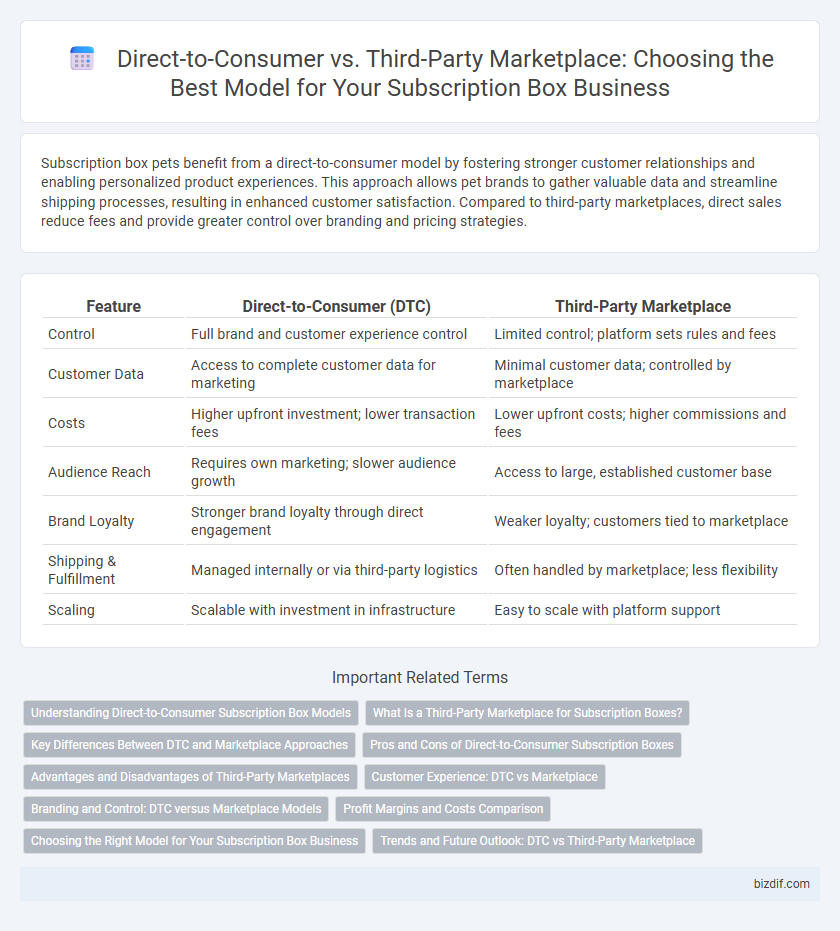Subscription box pets benefit from a direct-to-consumer model by fostering stronger customer relationships and enabling personalized product experiences. This approach allows pet brands to gather valuable data and streamline shipping processes, resulting in enhanced customer satisfaction. Compared to third-party marketplaces, direct sales reduce fees and provide greater control over branding and pricing strategies.
Table of Comparison
| Feature | Direct-to-Consumer (DTC) | Third-Party Marketplace |
|---|---|---|
| Control | Full brand and customer experience control | Limited control; platform sets rules and fees |
| Customer Data | Access to complete customer data for marketing | Minimal customer data; controlled by marketplace |
| Costs | Higher upfront investment; lower transaction fees | Lower upfront costs; higher commissions and fees |
| Audience Reach | Requires own marketing; slower audience growth | Access to large, established customer base |
| Brand Loyalty | Stronger brand loyalty through direct engagement | Weaker loyalty; customers tied to marketplace |
| Shipping & Fulfillment | Managed internally or via third-party logistics | Often handled by marketplace; less flexibility |
| Scaling | Scalable with investment in infrastructure | Easy to scale with platform support |
Understanding Direct-to-Consumer Subscription Box Models
Direct-to-consumer (DTC) subscription box models enable brands to sell products directly to customers, fostering personalized experiences and stronger customer relationships while retaining full control over branding and data. These models often result in higher profit margins compared to third-party marketplaces, which impose fees and limit direct interaction with subscribers. Leveraging DTC subscription boxes allows companies to gather valuable consumer insights, optimize inventory, and implement targeted marketing strategies for sustained growth.
What Is a Third-Party Marketplace for Subscription Boxes?
A third-party marketplace for subscription boxes is an online platform where multiple brands list and sell their curated subscription services to consumers. These marketplaces handle customer acquisition, payment processing, and often offer a variety of subscription box categories in one place, increasing visibility and convenience. Unlike direct-to-consumer models, third-party marketplaces provide a centralized hub that helps subscription businesses reach a broader audience without managing their own e-commerce infrastructure.
Key Differences Between DTC and Marketplace Approaches
Direct-to-consumer (DTC) subscription boxes offer brands full control over customer experience, data ownership, and personalized marketing, resulting in higher profit margins and brand loyalty. Third-party marketplaces provide broad exposure and reduced customer acquisition costs but limit direct interaction and data access, often involving commission fees that impact profitability. Choosing between DTC and marketplace models depends on a brand's strategic focus on control, customer relationships, and scalable distribution channels.
Pros and Cons of Direct-to-Consumer Subscription Boxes
Direct-to-consumer subscription boxes offer brands complete control over customer experience, data collection, and profit margins, enhancing brand loyalty and personalized marketing strategies. However, they require significant investment in marketing, customer acquisition, and logistics infrastructure to build and maintain a subscriber base. This approach contrasts with third-party marketplaces, where brands benefit from existing traffic but face reduced control and lower margins.
Advantages and Disadvantages of Third-Party Marketplaces
Third-party marketplaces offer subscription box businesses access to extensive customer bases and streamlined logistics, reducing marketing and fulfillment costs. However, they impose fees and limit brand control, which can dilute customer experience and reduce profit margins. Sellers may face increased competition and less direct customer data, hindering personalized marketing efforts.
Customer Experience: DTC vs Marketplace
Direct-to-consumer (DTC) subscription boxes provide a personalized customer experience with tailored product selections and direct support, enhancing brand loyalty and engagement. Third-party marketplaces offer convenience and variety but often dilute the brand experience, leading to less personalized interactions and slower issue resolution. DTC models enable companies to gather first-party data for continuous customization, improving customer satisfaction over marketplace alternatives.
Branding and Control: DTC versus Marketplace Models
Direct-to-consumer (DTC) subscription boxes offer brands complete control over their branding, customer experience, and data collection, enabling personalized marketing and stronger customer loyalty. Third-party marketplaces limit branding opportunities and control, as they standardize product presentation and customer interactions across multiple sellers. This often results in reduced brand differentiation and less direct access to customer insights compared to DTC models.
Profit Margins and Costs Comparison
Direct-to-consumer subscription boxes typically yield higher profit margins by eliminating third-party fees and maintaining full control over branding and customer data. Third-party marketplaces often incur commission costs and marketing expenses that reduce overall profitability. Balancing reduced operational overhead in direct-to-consumer models with broader audience reach from third-party platforms is crucial for optimizing subscription box business costs.
Choosing the Right Model for Your Subscription Box Business
Choosing the right model for your subscription box business involves evaluating direct-to-consumer (DTC) versus third-party marketplace options. DTC offers greater control over branding, customer data, and profit margins, enabling personalized customer experiences and tailored marketing strategies. Third-party marketplaces provide access to established audiences and reduced customer acquisition costs but often involve higher fees and less control over customer relationships.
Trends and Future Outlook: DTC vs Third-Party Marketplace
Direct-to-consumer (DTC) subscription boxes continue to gain momentum with personalized experiences and brand loyalty driving growth, while third-party marketplaces leverage wider customer reach and convenience to expand their subscription offerings. Recent trends indicate an increasing number of brands adopting hybrid models that combine DTC control with marketplace exposure to optimize customer acquisition and retention. Future outlooks predict sustained DTC dominance for niche and premium products, with marketplaces evolving through enhanced technology integrations and curated selections to remain competitive.
direct-to-consumer vs third-party marketplace Infographic

 bizdif.com
bizdif.com